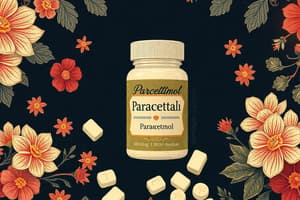Podcast
Questions and Answers
What is the maximum dose of paracetamol for adults within 24 hours?
What is the maximum dose of paracetamol for adults within 24 hours?
- 3g
- 4g (correct)
- 2g
- 5g
Paracetamol can be used to treat inflammation.
Paracetamol can be used to treat inflammation.
False (B)
What is the half-life of paracetamol?
What is the half-life of paracetamol?
3 hours
Paracetamol is classified as an _______ and antipyretic.
Paracetamol is classified as an _______ and antipyretic.
Match the following doses with the corresponding weight category for adults:
Match the following doses with the corresponding weight category for adults:
Which of the following is a contraindication for using paracetamol?
Which of the following is a contraindication for using paracetamol?
Bradycardia can occur as a side effect from rapid infusion of paracetamol.
Bradycardia can occur as a side effect from rapid infusion of paracetamol.
What is the primary action of paracetamol in reducing fever?
What is the primary action of paracetamol in reducing fever?
Flashcards are hidden until you start studying
Study Notes
Classification and Schedule
- Paracetamol (Acetaminophen) is classified as an analgesic and antipyretic.
- Schedule 1 medication with a maximum quantity of 3 x 1g bottles/bags on hand.
Pharmacokinetics
- Onset of action occurs within 5-10 minutes, peaking at about 1 hour.
- Half-life is approximately 3 hours.
- Duration of action lasts for 4-6 hours.
Pharmacological Action
- Acts as a simple analgesic, alleviating pain and reducing fever.
- Inhibits prostaglandin synthesis by blocking different Cyclooxygenase (COX) variants in the CNS.
- Desensitizes nerve endings to pain but does not directly affect inflammation at injury sites.
- Does not impact gastrointestinal mucosa or platelet function.
- Reduces pyrexia by acting on the hypothalamus.
Indications
- Recommended for short-term treatment of moderate to severe pain.
- Effective in managing pyrexia of any origin.
Contraindications
- Not suitable for individuals with hypersensitivity to Paracetamol.
- Should be avoided in cases of severe hepatic or renal insufficiency.
Adverse Effects
- May induce bradycardia when infused rapidly.
- Skin reactions are rare.
Packaging
- Available in two formulations:
- 1 g/100ml (10g/ml)
- 500 mg/50ml (10g/ml)
Trade Names
- Commonly marketed under the trade name Perfalgan.
Dosage and Administration
-
Adults:
- For patients weighing less than 50 kg: administer 15 mg/kg slowly via IV infusion over 20 minutes, every 4-6 hours.
- For patients over 50 kg: administer 1g (20 mg/kg) slowly via IV infusion over 20 minutes, every 4-6 hours.
- Maximum single dose: 15 mg/kg.
- Maximum total dose: not to exceed 4g in 24 hours.
-
Pediatrics:
- For children weighing more than 10 kg: administer 15 mg/kg slowly via IV infusion over 20 minutes, every 4-6 hours.
- For children under 10 kg: administer 7.5 mg/kg slowly via IV infusion over 20 minutes, every 4-6 hours.
- Maximum single dose: 15 mg/kg.
- Maximum dose in 24 hours:
- For children over 10 kg: 60 mg/kg.
- For children under 10 kg: 30 mg/kg.
Precautions
- Caution is advised in cases of malnourishment (e.g., anorexia, bulimia, cachexia).
- The 50ml bag/vial should be either administered over 15 minutes or diluted with 350 ml of Normal Saline for infusion.
Studying That Suits You
Use AI to generate personalized quizzes and flashcards to suit your learning preferences.


